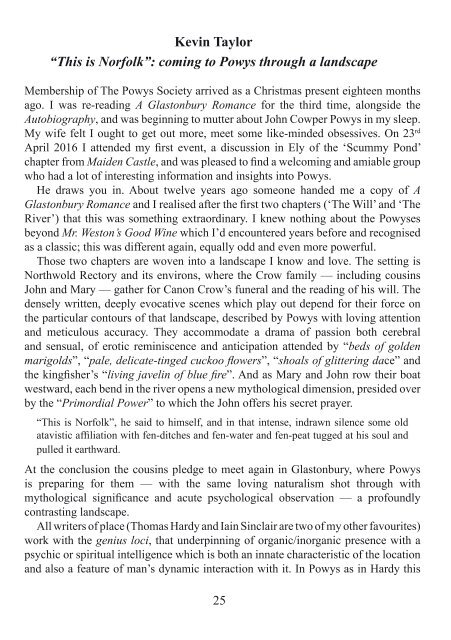Powys Society Newsletter 88
Create successful ePaper yourself
Turn your PDF publications into a flip-book with our unique Google optimized e-Paper software.
Kevin Taylor<br />
“This is Norfolk”: coming to <strong>Powys</strong> through a landscape<br />
Membership of The <strong>Powys</strong> <strong>Society</strong> arrived as a Christmas present eighteen months<br />
ago. I was re-reading A Glastonbury Romance for the third time, alongside the<br />
Autobiography, and was beginning to mutter about John Cowper <strong>Powys</strong> in my sleep.<br />
My wife felt I ought to get out more, meet some like-minded obsessives. On 23 rd<br />
April 2016 I attended my first event, a discussion in Ely of the ‘Scummy Pond’<br />
chapter from Maiden Castle, and was pleased to find a welcoming and amiable group<br />
who had a lot of interesting information and insights into <strong>Powys</strong>.<br />
He draws you in. About twelve years ago someone handed me a copy of A<br />
Glastonbury Romance and I realised after the first two chapters (‘The Will’ and ‘The<br />
River’) that this was something extraordinary. I knew nothing about the <strong>Powys</strong>es<br />
beyond Mr. Weston’s Good Wine which I’d encountered years before and recognised<br />
as a classic; this was different again, equally odd and even more powerful.<br />
Those two chapters are woven into a landscape I know and love. The setting is<br />
Northwold Rectory and its environs, where the Crow family — including cousins<br />
John and Mary — gather for Canon Crow’s funeral and the reading of his will. The<br />
densely written, deeply evocative scenes which play out depend for their force on<br />
the particular contours of that landscape, described by <strong>Powys</strong> with loving attention<br />
and meticulous accuracy. They accommodate a drama of passion both cerebral<br />
and sensual, of erotic reminiscence and anticipation attended by “beds of golden<br />
marigolds”, “pale, delicate-tinged cuckoo flowers”, “shoals of glittering dace” and<br />
the kingfisher’s “living javelin of blue fire”. And as Mary and John row their boat<br />
westward, each bend in the river opens a new mythological dimension, presided over<br />
by the “Primordial Power” to which the John offers his secret prayer.<br />
“This is Norfolk”, he said to himself, and in that intense, indrawn silence some old<br />
atavistic affiliation with fen-ditches and fen-water and fen-peat tugged at his soul and<br />
pulled it earthward.<br />
At the conclusion the cousins pledge to meet again in Glastonbury, where <strong>Powys</strong><br />
is preparing for them — with the same loving naturalism shot through with<br />
mythological significance and acute psychological observation — a profoundly<br />
contrasting landscape.<br />
All writers of place (Thomas Hardy and Iain Sinclair are two of my other favourites)<br />
work with the genius loci, that underpinning of organic/inorganic presence with a<br />
psychic or spiritual intelligence which is both an innate characteristic of the location<br />
and also a feature of man’s dynamic interaction with it. In <strong>Powys</strong> as in Hardy this<br />
25


